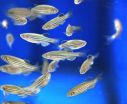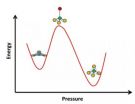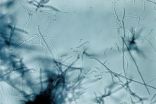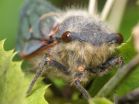(Press-News.org) This news release is available in German.
The zebrafish, a small fresh water fish, owes its name to a striking pattern of blue stripes alternating with golden stripes. Three major pigment cell types, black cells, reflective silvery cells, and yellow cells emerge during growth in the skin of the tiny juvenile fish and arrange as a multilayered mosaic to compose the characteristic colour pattern.
While it was known that all three cell types have to interact to form proper stripes, the embryonic origin of the pigment cells that develop the stripes of the adult fish has remained a mystery up to now. Scientists of the Max Planck Institute for Developmental Biology in Tübingen have now discovered how these cells arise and behave to form the 'zebra' pattern. Their work may help to understand the development and evolution of the great diversity of striking patterns in the animal world.
Beauty in the living world amazes poets, philosophers and scientists alike. Nobel prize laureate Christiane Nüsslein-Volhard, Director of the Department for Genetics at the Max Planck Institute for Developmental Biology, has long been fascinated by the biology behind the colour patterns displayed by animals. Her group uses zebrafish as a model organism to study the genetic basis of animal development.
New research by Nüsslein-Volhard's laboratory published in Science shows that the yellow cells undergo dramatic changes in cell shape to tint the stripe pattern of zebrafish. "We were surprised to observe such cell behaviours, as these were totally unexpected from what we knew about colour pattern formation", says Prateek Mahalwar, first author of the study. The study builds on a previous work from the laboratory, which was published in June this year in Nature Cell Biology (NCB), tracing the cell behaviour of silvery and black cells. Both studies describe diligent experiments to uncover the cellular events during stripe pattern formation. Individual juvenile fish carrying fluorescently labelled pigment cell precursors were imaged every day for up to three weeks to chart out the cellular behaviours. This enabled the scientists to trace the multiplication, migration and spreading of individual cells and their progeny over the entire patterning process of stripe formation in the living and growing animal. "We had to develop a very gentle procedure to be able to observe individual fish repeatedly over long periods of time. So we used a state of the art microscope which allowed us to reduce the adverse effects of fluorescence illumination to a minimum," says Ajeet Singh, first author of the earlier NCB study.
Surprisingly, the analysis revealed that the three cell types reach the skin by completely different routes: A pluripotent cell population situated at the dorsal side of the embryo gives rise to larval yellow cells, which cover the skin of the embryo. These cells begin to multiply at the onset of metamorphosis when the fish is about two to three weeks old. However, the black and silvery cells come from a small set of stem cells associated with nerve nodes located close to the spinal cord in each segment. The black cells reach the skin migrating along the segmental nerves to appear in the stripe region, whereas the silvery cells pass through the longitudinal cleft that separates the musculature and then multiply and spread in the skin.
Brigitte Walderich, a co-author of the Science paper, who performed cell transplantations to trace the origin of yellow cells, explains: "My attempt was to create small clusters of fluorescently labelled cells in the embryo which could be followed during larval and juvenile stages to unravel growth and behaviour of the yellow cells. We were surprised to discover that they divide and multiply as differentiated cells to cover the skin of the fish before the silvery and black cells arrive to form the stripes."
A striking observation is that both the silvery and yellow cells are able to switch cell shape and colour, depending on their location. The yellow cells compact to closely cover the dense silvery cells forming the light stripe, colouring it golden, and acquire a loose stellate shape over the black cells of the stripes. The silvery cells thinly spread over the stripe region, giving it a blue tint. They switch shape again at a distance into the dense form to aggregate, forming a new light stripe. These cell behaviours create a series of alternating light and dark stripes. The precise superposition of the dense form of silvery and yellow cells in the light stripe, and the loose silvery and yellow cells superimposed over the black cells in the stripe cause the striking contrast between the golden and blue coloration of the pattern.
The authors speculate that variations on these cell behaviours could be at play in generating the great diversity of colour patterns in fish. "These findings inform our way of thinking about colour pattern formation in other fish, but also in animals which are not accessible to direct observation during development such as peacocks, tigers and zebras", says Nüsslein-Volhard.
INFORMATION:
Original publications:
Ajeet Pratap Singh, Ursula Schach, Christiane Nüsslein-Volhard
Proliferation, dispersal and patterned aggregation of iridophores in the skin prefigure striped colouration of zebrafish.
Nature Cell Biology 15, 1098-1106
Prateek Mahalwar, Brigitte Walderich, Ajeet Pratap Singh, and Christiane Nüsslein-Volhard
Local reorganization of xanthophores fine-tunes and colors the striped pattern of zebrafish.
Science, 29 August 2014
How the zebrafish gets its stripes
Max Planck scientists uncover how beautiful colour patterns can develop in animals
2014-08-28
ELSE PRESS RELEASES FROM THIS DATE:
Watching the structure of glass under pressure
2014-08-28
Glass has many applications that call for different properties, such as resistance to thermal shock or to chemically harsh environments. Glassmakers commonly use additives such as boron oxide to tweak these properties by changing the atomic structure of glass. Now researchers at the University of California, Davis, have for the first time captured atoms in borosilicate glass flipping from one structure to another as it is placed under high pressure.
The findings may have implications for understanding how glasses and similar "amorphous" materials respond at the atomic ...
Bradley Hospital collaborative study identifies genetic change in autism-related gene
2014-08-28
PROVIDENCE, R.I. – A new study from Bradley Hospital has identified a genetic change in a recently identified autism-associated gene, which may provide further insight into the causes of autism. The study, now published online in the Journal of Medical Genetics, presents findings that likely represent a definitive clinical marker for some patients' developmental disabilities.
Using whole-exome sequencing – a method that examines the parts of genes that regulate protein, called exons - the team identified a genetic change in a newly recognized autism-associated gene, Activity-Dependent ...
Yale study identifies possible bacterial drivers of IBD
2014-08-28
Yale University researchers have identified a handful of bacterial culprits that may drive inflammatory bowel diseases (IBD) such as Crohn's disease and ulcerative colitis, using patients' own intestinal immune responses as a guide.
The findings are published Aug. 28 in the journal Cell.
Trillions of bacteria exist within the human intestinal microbiota, which plays a critical role in the development and progression of IBD. Yet it's thought that only a small number of bacterial species affect a person's susceptibility to IBD and its potential severity.
"A handful ...
Drug shows promise against Sudan strain of Ebola in mice
2014-08-28
August 28, 2014 — (BRONX, NY) — Researchers from Albert Einstein College of Medicine of Yeshiva University and other institutions have developed a potential antibody therapy for Sudan ebolavirus (SUDV), one of the two most lethal strains of Ebola. A different strain, the Zaire ebolavirus (EBOV), is now devastating West Africa. First identified in 1976, SUDV has caused numerous Ebola outbreaks (most recently in 2012) that have killed more than 400 people in total. The findings were reported in ACS Chemical Biology.
Between 30 and 90 percent of people infected with Ebola ...
NASA sees a weaker Tropical Storm Marie
2014-08-28
When NOAA's GOES-West satellite captured an image of what is now Tropical Storm Marie, weakened from hurricane status on August 28, the strongest thunderstorms were located in the southern quadrant of the storm.
NOAA's GOES-West satellite captured an image of Marie on August 28 at 11 a.m. EDT. Bands of thunderstorms circled the storm especially to the north. The National Hurricane Center noted that Marie has continued to produce a small area of convection (rising air that forms the thunderstorms that make up Marie) south and east of the center during some hours on the ...
DeVincenzo study breakthrough in RSV research
2014-08-28
MEMPHIS, Tenn. – The New England Journal of Medicine published research results on Aug. 21 from a clinical trial of a drug shown to safely reduce the viral load and clinical illness of healthy adult volunteers intranasally infected with respiratory syncytial virus (RSV).
Le Bonheur Children's Hospital and the University of Tennessee Health Science Center researcher Infectious Disease Specialist John DeVincenzo, MD, is lead author of this study.
RSV is the most common cause of lower respiratory tract infections in young children in the United States and worldwide. ...
Small molecule acts as on-off switch for nature's antibiotic factory
2014-08-28
DURHAM, N.C. -- Scientists have identified the developmental on-off switch for Streptomyces, a group of soil microbes that produce more than two-thirds of the world's naturally derived antibiotic medicines.
Their hope now would be to see whether it is possible to manipulate this switch to make nature's antibiotic factory more efficient.
The study, appearing August 28 in Cell, found that a unique interaction between a small molecule called cyclic-di-GMP and a larger protein called BldD ultimately controls whether a bacterium spends its time in a vegetative state or ...
Second-hand e-cig smoke compared to regular cigarette smoke
2014-08-28
E-cigarettes are healthier for your neighbors than traditional cigarettes, but still release toxins into the air, according to a new study from USC.
Scientists studying secondhand smoke from e-cigarettes discovered an overall 10-fold decrease in exposure to harmful particles, with close-to-zero exposure to organic carcinogens. However, levels of exposure to some harmful metals in second-hand e-cigarette smoke were found to be significantly higher.
While tobacco smoke contains high levels of polycyclic aromatic hydrocarbons – cancer-causing organic compounds – the level ...
Healthy Moms program helps women who are obese limit weight gain during pregnancy
2014-08-28
PORTLAND, Ore., August 28, 2014 — A new study finds that women who are obese can limit their weight gain during pregnancy using conventional weight loss techniques including attending weekly group support meetings, seeking advice about nutrition and diet, and keeping food and exercise journals.
Results of the Healthy Moms study, published in Obesity, also show that obese women who limit their weight gain during pregnancy are less likely to have large-for-gestational age babies which can complicate delivery and increase the baby's risk of becoming obese later in life.
"Most ...
University of Montana cicada study discovers 2 genomes that function as 1
2014-08-28
MISSOULA, Mont. – Two is company, three is a crowd. But in the case of the cicada, that's a good thing.
Until a recent discovery by a University of Montana research lab, it was thought that cicadas had a symbiotic relationship with two important bacteria that live within the cells of its body. Since the insect eats a simple diet consisting solely of plant sap, it relies on these bacteria to produce the nutrients it needs for survival.
In exchange, those two bacteria, Hodgkinia and Sulcia, live comfortably inside the cicada. Since all three divvy up the nutritional roles, ...
LAST 30 PRESS RELEASES:
This self-powered eye tracker harnesses energy from blinking and is as comfortable as everyday glasses
Adverse prenatal exposures linked to higher rates of mental health issues, brain changes in adolescents
Restoring mitochondria shows promise for treating chronic nerve pain
Nature study identifies a molecular switch that controls transitions between single-celled and multicellular forms
USU chemists' CRISPR discovery could lead to single diagnostic test for COVID, flu, RSV
Early hominins from Morocco reveal an African lineage near the root of Homo sapiens
Small chimps, big risks: What chimps show us about our own behavior
We finally know how the most common types of planets are created
Thirty-year risk of cardiovascular disease among healthy women according to clinical thresholds of lipoprotein(a)
Yoga for opioid withdrawal and autonomic regulation
Gene therapy ‘switch’ may offer non-addictive pain relief
Study shows your genes determine how fast your DNA mutates with age
Common brain parasite can infect your immune cells. Here's why that's probably OK
International experts connect infections and aging through cellular senescence
An AI–DFT integrated framework accelerates materials discovery and design
Twist to reshape, shift to transform: Bilayer structure enables multifunctional imaging
CUNY Graduate Center and its academic partners awarded more than $1M by Google.org to advance statewide AI education through the Empire AI consortium
Mount Sinai Health system receives $8.5 million NIH grant renewal to advance research on long-term outcomes in children with congenital heart disease
Researchers develop treatment for advanced prostate cancer that could eliminate severe side effects
Keck Medicine of USC names Christian Pass chief financial officer
Inflatable fabric robotic arm picks apples
MD Anderson and SOPHiA GENETICS announce strategic collaboration to accelerate AI-driven precision oncology
Oil residues can travel over 5,000 miles on ocean debris, study finds
Korea University researchers discover that cholesterol-lowering drug can overcome chemotherapy resistance in triple-negative breast cancer
Ushikuvirus: A newly discovered giant virus may offer clues to the origin of life
Boosting the cell’s own cleanup
Movement matters: Light activity led to better survival in diabetes, heart, kidney disease
Method developed to identify best treatment combinations for glioblastoma based on unique cellular targets
Self-guided behavioral app helps children with epilepsy sleep earlier
Higher consumption of food preservatives is associated with an increased risk of type 2 diabetes
[Press-News.org] How the zebrafish gets its stripesMax Planck scientists uncover how beautiful colour patterns can develop in animals







